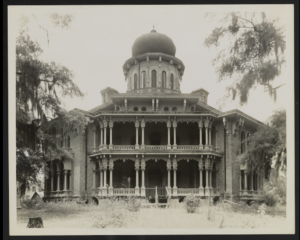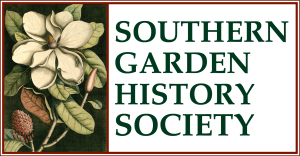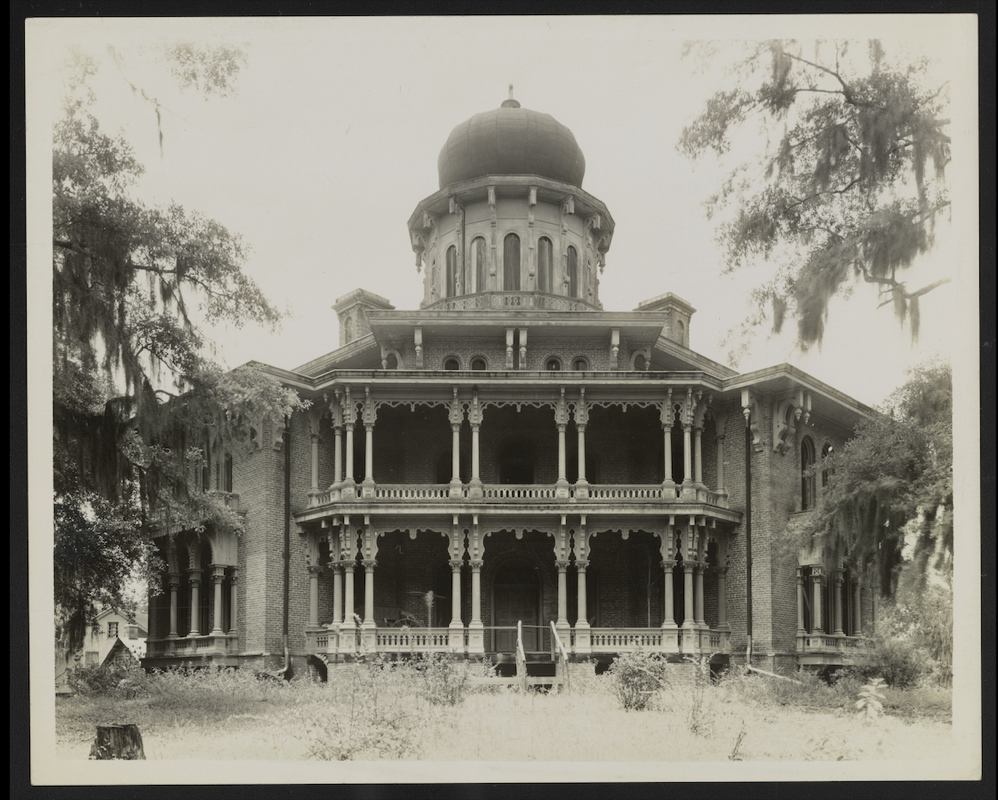
Over two decades have passed since members gathered in Natchez in 2002 to celebrate the Society’s twentieth anniversary. More amazingly, it has been forty-one years since our first meeting there in 1984. A central person at both functions was Natchez resident and founding board member Glenn Haltom, mother-in-law of Past-President Susan Haltom. In 2002, with Glenn Haltom serving as honorary committee chair, board member Dr. Elizabeth MacNeil Boggess took a leading organizing role, she and her sister Anne MacNeil also featuring their family-owned Natchez homes Cherry Grove and Elms Court among the scheduled site visits. A single Gardens page article, however, cannot do justice to the individual sites and the overall Natchez cultural landscape experienced during our annual meetings there. This will therefore be the first of several discussions of the time SGHS members explored this town both in the state of Mississippi and on the east bank of the river Mississippi.
Two properties stand out in reviewing the 1984 meeting: Rosalie and Longwood, both being National Historic Landmarks. Offering a pre-tour introduction to the former was long-time Natchez resident Betty Latta Ratcliffe who had played a key part in the Rosalie gardens restoration. Our honorary president and SGHS co-founder William Lanier (Bill) Hunt then discussed Longwood, arguably the best-known antebellum home in Natchez.*
Rosalie’s site is significant at several levels. As readers may know, the grand house is called Rosalie after the former French fort that once stood south of the property visited by SGHS members in 1984. Built on the Mississippi bluffs in 1716, Fort Rosalie was named for Rosalie de Pontchartrain, the wife of France’s minister of marine. While Fort Rosalie helps to anchor the history of Natchez as a European-American settlement, the story of the region’s earlier indigenous heritage is long and complex, being succinctly told in Dr. Boggess’ Magnolia article linked below.** Her essay also discusses the place in regional history of Scottish planter, inventor, explorer, scientist, experimenter, Thomas Jefferson correspondent, and Natchez town planner William Dunbar. His “The Forest” plantation, Boggess notes, had an arboretum “said to have encompassed 150 acres,” that being joined by notable “landscaped gardens.”
Aided by some of Dunbar’s inventions (and those of his enslaved blacksmith Barclay), cotton would come to reign in Natchez. It was sawmill profits, however, that allowed Pennsylvania native Peter Little to buy the twenty-five-acre Fort Rosalie site in the 1820s and build his brick Federal-to-Greek Revival transitional home. Overlooking the Mississippi, Rosalie’s grounds are shaded by numerous live oaks and enclosed by the combination of a finely-articulated early picket fence and matching gate, these features then connecting to brick walls that border Orleans and South Canal Streets. Reflecting late-twentieth-century design work and plantings, the gardens consist largely of grass lawn and geometrical beds containing evergreen and flowering shrubs. These features are then complemented by bulbs, perennials, and annuals typifying early Natchez gardens. Long owned and operated by the DAR, Rosalie also served as Union Army offices in the 1860s and briefly as Ulysses Grant’s headquarters.
As a peripatetic young gardener and gardens consultant Bill Hunt became known in Natchez through visits and lectures, along with continuing letter writing. Doubtlessly, he knew Rosalie, but it was the never-completed Longwood that drew his rapt attention and imagination.*** In his 1982 book Southern Gardens, Southern Gardening 142-143) Hunt discusses the enormous octagonal house, designed by Philadelphia architect Samuel Sloan, and its gardens, both those that once existed, with their legendary roses, and those that might someday be recreated. (Hunt also references Shreveport rosarian Cleo Barnwell and his rose collecting efforts with her at the Natchez cemetery, clearly thinking of later repropagation in local gardens.)
The Longwood admired by Bill Hunt was one of six plantations belonging to the pro-Union Haller Nutt and his wife Julia. Totaling approximately 43,000 acres, this land was worked by an enslaved force of eight hundred people, some of whom labored at the family’s Natchez Longwood home. As Mac Griswold writes in The Golden Age of American Gardens (227-229), Longwood’s ninety-acre grounds were a picturesque combination of “parkland and ornamental garden” overlooking the river, the wooded sections mixing native trees with exotic and colorful non-native specimens. Said to be the creation of a Philadelphia landscape gardener, Mark Kyle, the formal gardens consisted of fifteen terraced acres, ten being devoted to the cultivation of “500 varieties of roses.” Like other such sites, Longwood’s grounds also featured vegetable gardens and orchards, these becoming invaluable to Julia Nutt in the lean post-1865 years.
Owned by the Pilgrimage Garden Club since 1970, the house sits amid grass lawns bordered by a pond to the southeast and populated, inter alia, with live oaks, bald cypress trees, and Southern magnolias. While roses are no longer featured, other plants of visitor interest are azaleas, sweet olive, flowering quince, and a bigleaf magnolia. As well, the site encompasses a large enslaved household workers’ quarters, a carriage house, and the Nutt family cemetery where both Haller (d. 1864) and Julia (d. 1897) found their final resting places.
*********************************************************
*For the Rosalie and Longwood National Register nominations, see: https://www.apps.mdah.ms.gov/nom/prop/345.pdf and https://npgallery.nps.gov/NRHP/GetAsset/NHLS/69000079_text
**https://southerngardenhistory.org/wp-content/uploads/2015/12/Magnolia_Fall_2001.pdf#page=1
***For numerous details on Longwood’s construction, see: https://www.americanheritage.com/longwood-untimely-octagon


Leave a Reply